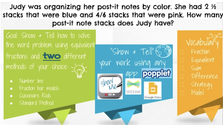|
Our next story comes from Elizabeth Dobrinen and her team at Madison Elementary School. Elizabeth is a RSP teacher working with students across multiple grade levels. Madison's 4th grade PLC and Elizabeth were in our UDL pilots for the 2016-2017 school year doing some incredible work in the area of professional teaming and support of students of diverse sets of needs. Here is her story!  The use of the UDL instructional planning process allows our UDL team to regularly establish clear outcomes, anticipate learner needs and measure their success. UDL also promotes collaboration among staff, student self-sufficiency and student advocacy amongst both general and special education students. Investigating the learner’s preferences for representation, expression and engagement allows our team to work together to discover the strengths of each student in the area of learning and assessment. For example: the 4th grade standard of area multiplication can be daunting for any student. As a team we created two model options for students to help guide them through the steps. Students were given a choice of what model worked for their learning style. Options were also given for their learning environment. Based on data and/or IEP goals, students from all three classes were directed to a small group setting in the back of the classroom. With the RSP teacher, students strengthened their understanding of the standard with their choice of the math model. Additionally, any student can ask to request learning in a small group setting or large group for guided support. Students regularly take teachers up on this option. To ensure generalization of the standard taught, students regularly are asked to “teach” their peers to support their learning and the learning of their peers. Data showed that with options with assessment styles (one to one setting, test read to student, white board, multiplication tables) students increased their scores by 70%. Our 4th grade pilot program has now extended to collaboration with 5th grade and students are demonstrating success. As a staff that collaborates regularly together we are having a better understanding of UDL and how to ensure success for all students. Elizabeth Dobrinen (RSP) & the UDL team Madison Elementary School
1 Comment
Our next story from the field comes from Jessica Mireles, 5th grade teacher from Sanger Academy Charter. Her and Delilah Isaak, her PLC partner, are some of amongst most innovative UDL practitioners. Here she is addressing the instructional design evolution she experienced in her application of Universal Design for Learning with her students. I have always believed in teaching through a universal design lens, where all students needs could be met regardless of their background and skills. UDL has provided the framework for allowing more students to succeed in the classroom and take ownership of their learning. Through this journey in UDL, I have found that there were two major components of implementation: environmental and providing both engaging and meaningful lessons/activities. In my classroom, we learn through many hands on and relevant activities to understand a concept. We build, discuss, analyze through real life situations, tasks, and projects. Time after time, I hear students say “even though we have to do the math, it’s really fun!” or “can we learn like this all the time?” I have found that students have been able to deepen their knowledge when they are fully engaged in a lesson or activity. Having a visual or something physical to supplement learning goes a long way. For example, students are able to understand multiplication using the area model in a physical space of tiles in the classroom or using base ten blocks or measuring and finding the area of objects and spaces around the classroom. Students also recently created a family dinner through shopping while adding, subtracting and multiplying decimals. The UDL model is extremely beneficial when teaching ELA standards the otherwise would not be appealing to students. Some activities, such as teaching opinion/argumentative writing through short debates, creating Colonial Commercials or learning new greek & latin roots through researching of new words and creating a portfolio on google slides, leave students requesting more of the same activities. As a teacher, these are the type of lessons and activities I strive for everyday. Although my classroom is extremely structured with rules and procedures, students have choice as to how and where they learn. Depending on the assignment and whether they are working individually or with their peers, students can work in designated areas of the classroom. We have a large round table suitable for group work, a student whiteboard on the back wall, a comfy library area, a plethora of stools for extra seating anywhere in the classroom, floor space, standing desks, work tables as well as the option to work outside the classroom door if appropriate. All of the choices must be earned and expectations must be followed, not all students have these privileges. My students have learned to earn different levels of “choice”. No matter what the classroom looks like, each students is accountable and responsible for their work. Overall, UDL has expanded my classroom and teaching style. Although it takes dedication and a creative mind to create these activities and tasks, the end product of what students receive gives more of an opportunity for student success. Students are motivated and learn more when we make teaching fun. Because these activities require immense classroom management, students become more responsible and “self-controlled” young learners. |
Sanger UnifiedArchives
January 2019
Categories
Podcast Archives
|
Pictures are Worth 1000 Words
|
Sanger unified school district |
Curriculum & Instruction department |




 RSS Feed
RSS Feed